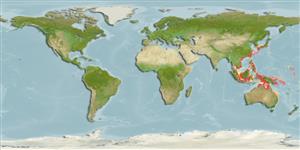Environment: milieu / climate zone / depth range / distribution range
Ecologia
marino demersale; distribuzione batimetrica 30 - 40 m (Ref. 9774). Tropical
Northwest Pacific: southern Japan to the South China Sea.
Size / Peso / Age
Maturity: Lm ? range ? - ? cm
Max length : 30.0 cm SL maschio/sesso non determinato; (Ref. 9774); common length : 15.0 cm SL maschio/sesso non determinato; (Ref. 9774); peso massimo pubblicato: 169.80 g (Ref. 124479)
Spine dorsali (totale) : 0; Raggi dorsali molli (totale) : 78 - 82; Spine anali: 0; Raggi anali molli: 61 - 65; Vertebre: 38. Two dark spots along gill opening below pectoral fin. Dark blotch a beginning of straight part of lateral line (Ref. 559). Soft ray count of pectoral fin refers to that on ocular side.
Inhabits muddy and sandy bottoms of the continental shelf (Ref. 9774). Feeds mainly on small demersal fishes (Ref. 9774). Marketed fresh (Ref. 9774).
Life cycle and mating behavior
Maturities | Riproduzione | Spawnings | Egg(s) | Fecundities | Larve
Distinct pairing (Ref. 205).
Masuda, H. and G.R. Allen, 1993. Meeresfische der Welt - Groß-Indopazifische Region. Tetra Verlag, Herrenteich, Melle. 528 p. (Ref. 9137)
IUCN Red List Status (Ref. 130435)
Threat to humans
Harmless
Human uses
Pesca: commerciale
Strumenti
Special reports
Download XML
Fonti Internet
Estimates based on models
Preferred temperature (Ref.
123201): 23.9 - 28.6, mean 28 °C (based on 95 cells).
Phylogenetic diversity index (Ref.
82804): PD
50 = 0.5000 [Uniqueness, from 0.5 = low to 2.0 = high].
Bayesian length-weight: a=0.00708 (0.00443 - 0.01132), b=3.14 (3.01 - 3.27), in cm total length, based on LWR estimates for this species & Genus-body shape (Ref.
93245).
Trophic level (Ref.
69278): 4.2 ±0.73 se; based on food items.
Resilienza (Ref.
120179): Alto, tempo minimo di raddoppiamento della popolazione meno di 15 mesi (Preliminary K or Fecundity.).
Fishing Vulnerability (Ref.
59153): Low to moderate vulnerability (27 of 100).
